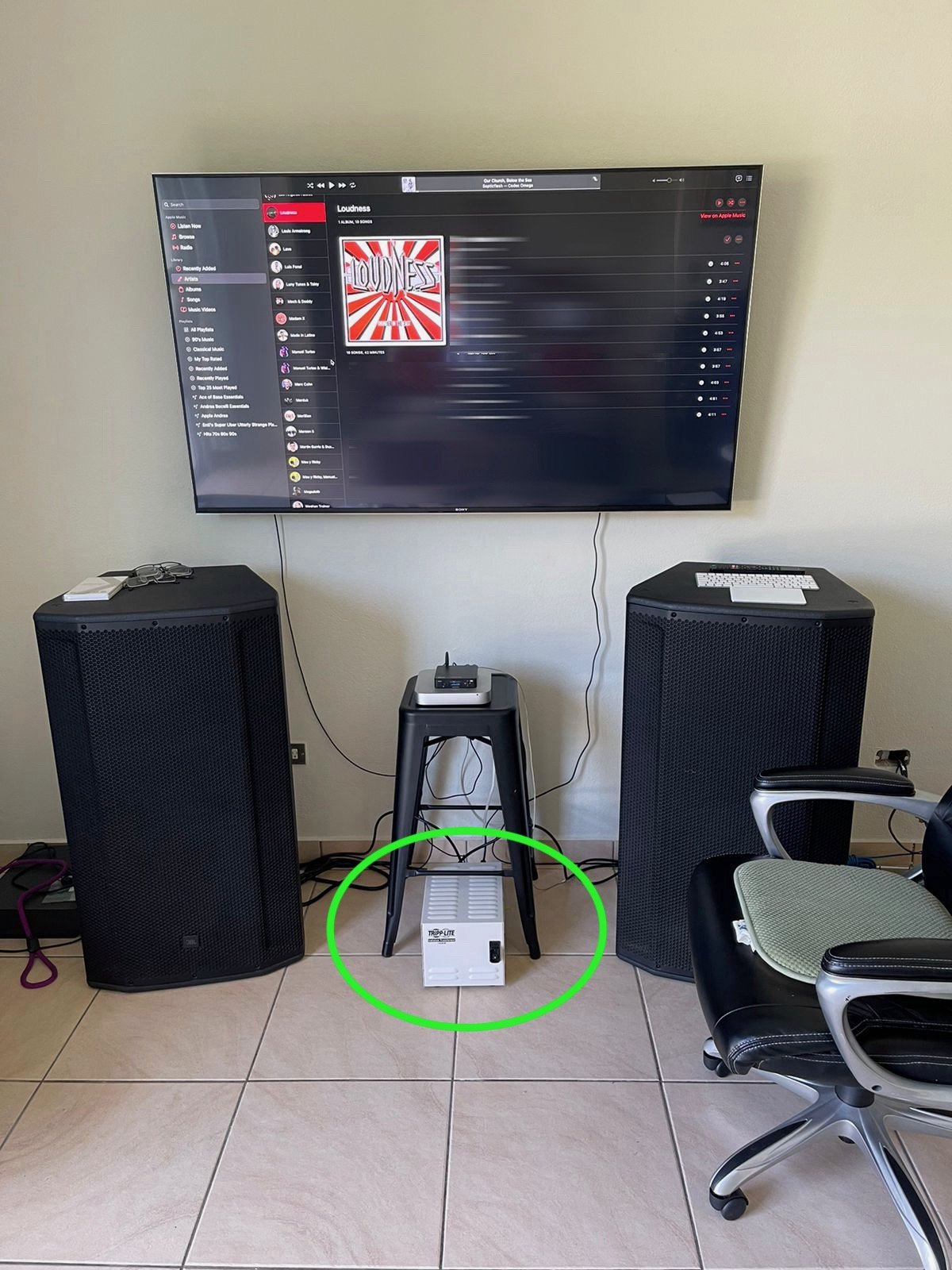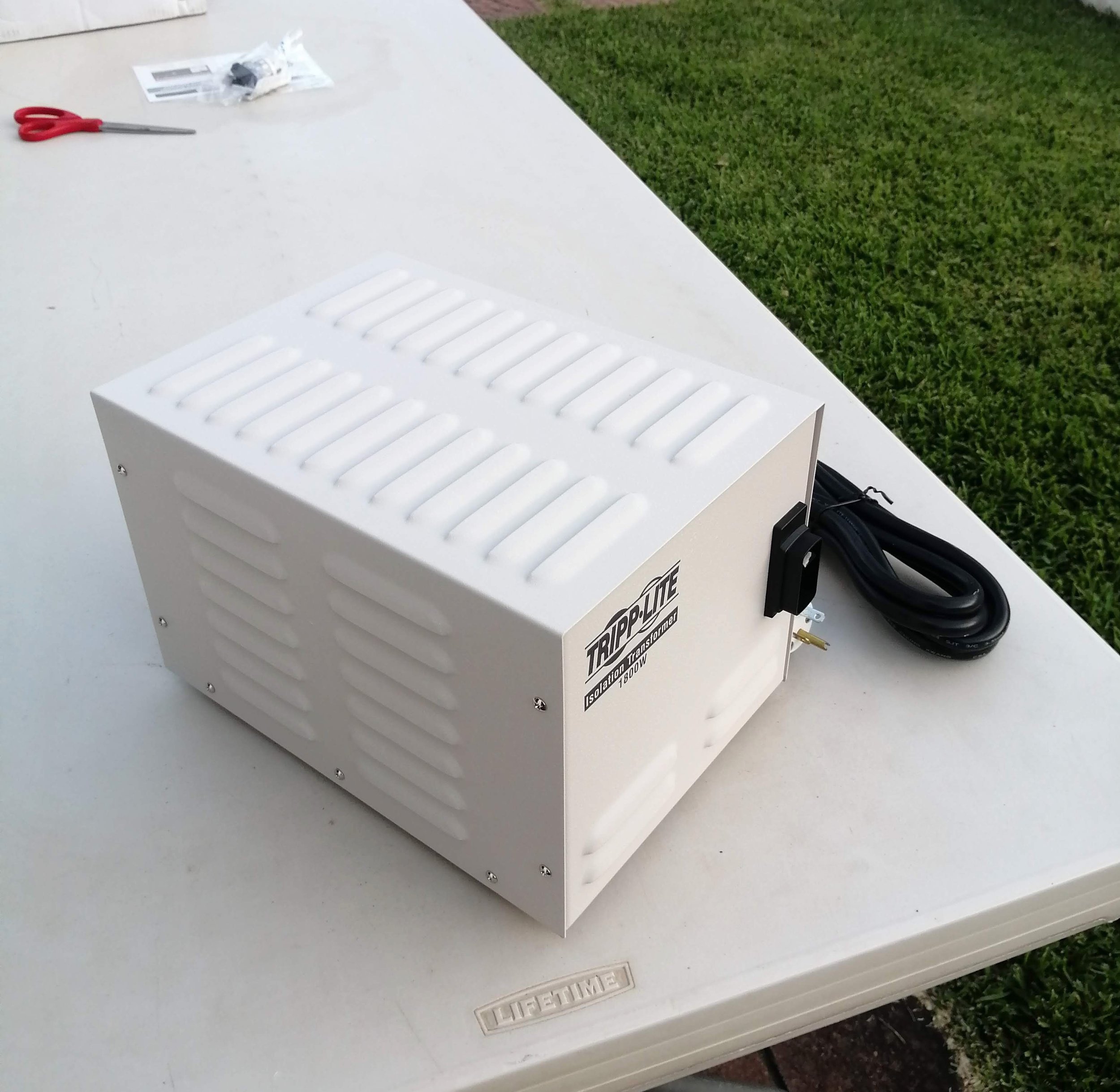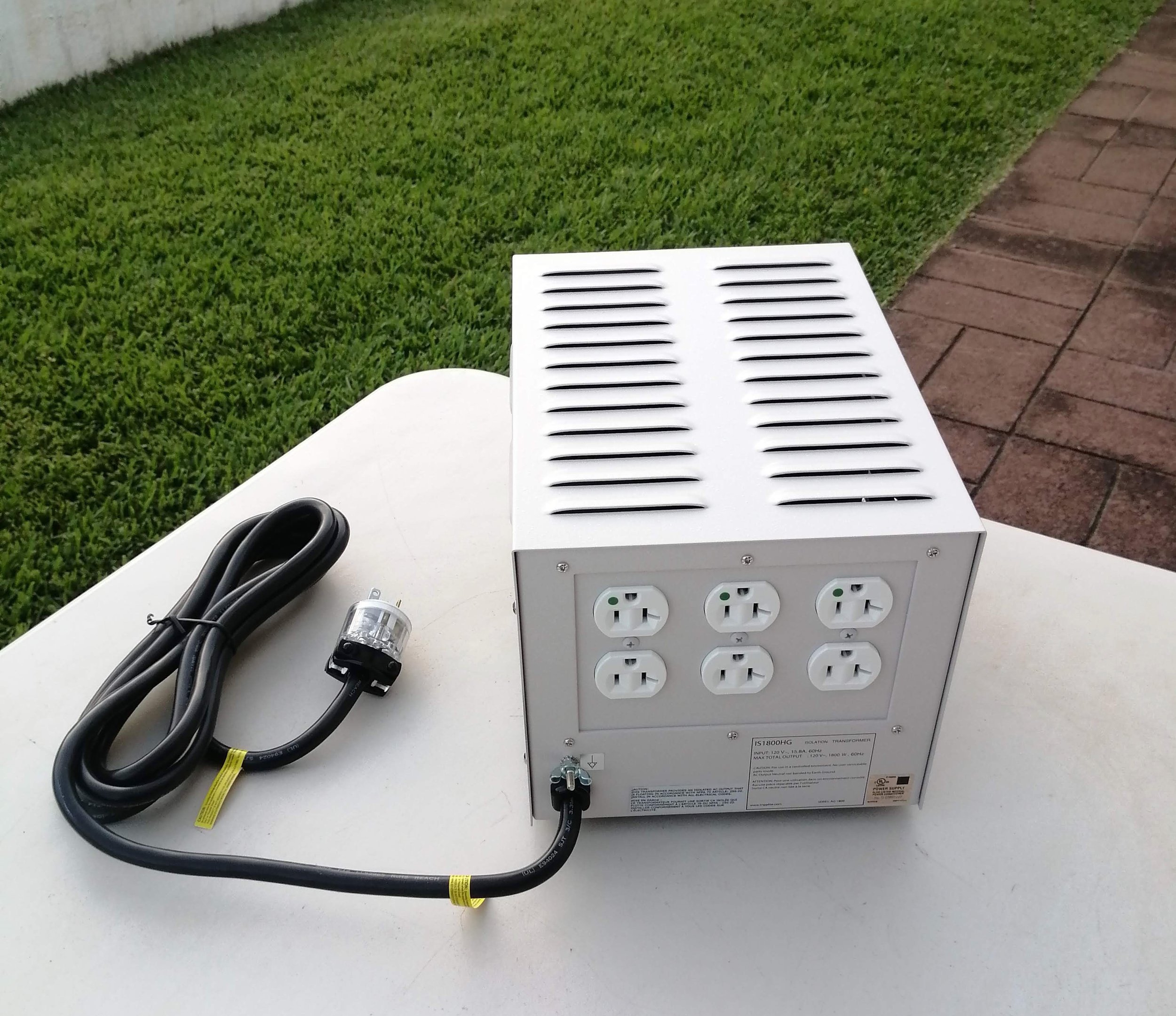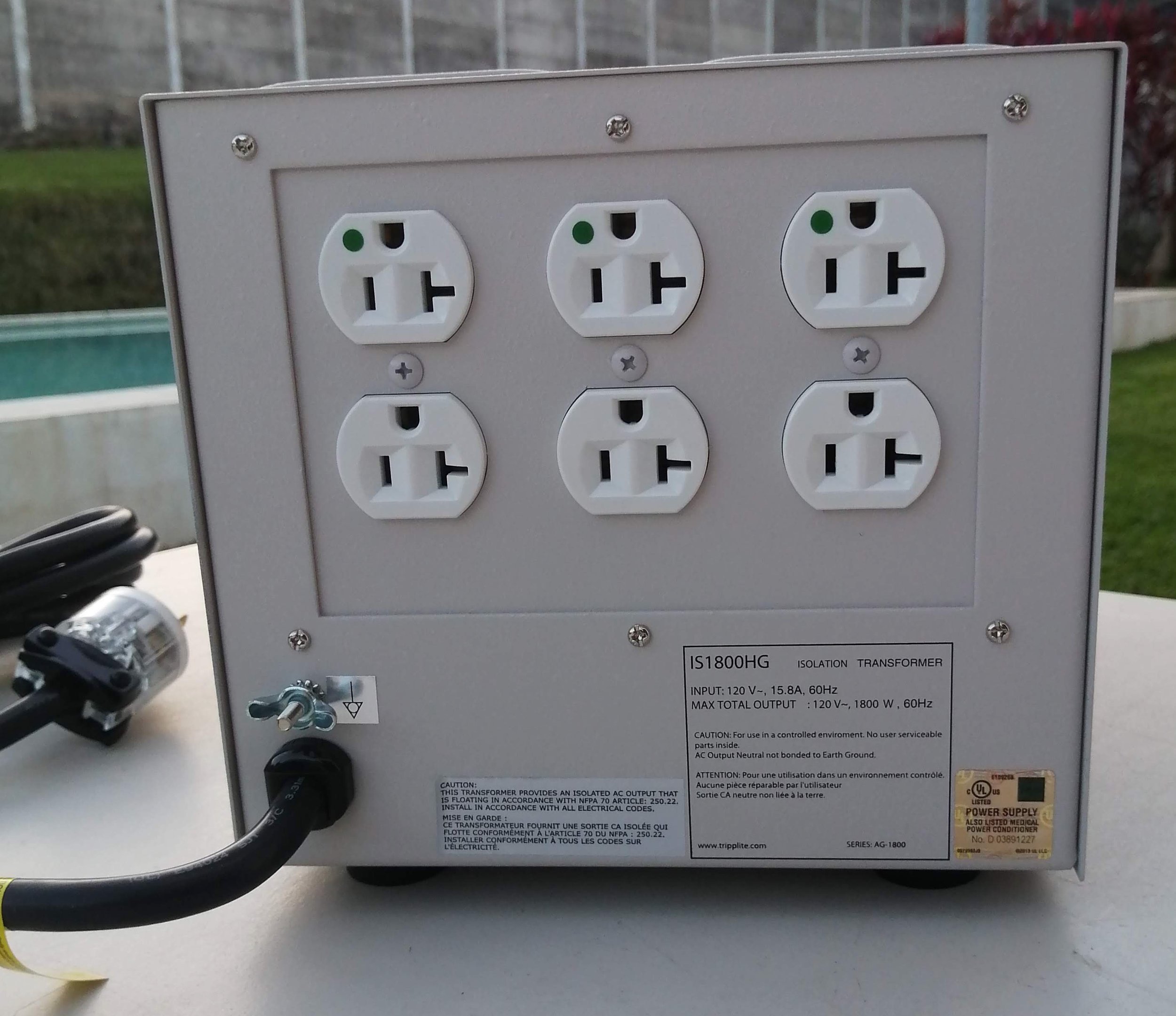Posted: May 29, 2022
A power struggle in the quest for clean audio: The isolation transformer versus the double conversion online UPS
Ground loops and non-linear loads like fluorescent lights, sparking electric motors, and switching power supplies (such as those found in computers) are, all, very annoying, ubiquitous sources of line noise. If you want to just sit down and enjoy your music peacefully, while the troubles of the world around you disappear, clean power is essential.
Isolation transformers and double conversion online uninterruptible power supplies are two ways in which you can defend yourself against line noise. My personal choice of weapon: The Tripp Lite IS1800HG isolation transformer.
At a hefty 60 pounds of shipping weight and an even heftier price tag of US$960.50 (locally, in El Salvador), the IS1800HG, literally, cannot be taken lightly.
The brick-like device you see between the speakers, in the picture above, is an isolation transformer; it provides galvanic isolation from the mains.
“Why does it have to be so big?” you ask. It doesn’t. But did you notice the size of those speakers? Those amps will be drawing a lot of power from the grid and you need to size your transformer for the current you expect it to handle.
For the record, let it be known, first of all, that the best source of clean power, for your audio system, would be a double-conversion online UPS, bar none.
A double-conversion online UPS takes “dirty” alternating current from the mains, converts it to direct current, stores it in a battery, draws direct current from that battery, and creates a clean, perfect, sinusoidal, alternating current waveform that will make every device, in your audio chain, a very happy device. Nothing can beat that.
Further, let it also be known that, unlike a double conversion online UPS, the isolation transformer does nothing to improve the power waveform; if the waveform is coming in choppy, from the mains, it will probably be choppy at the output.
Puzzled and intrigued, by my expensive and counterintuitive decision, you ask: “Pray tell us, then, by Poseidon’s Trident, why did you buy an isolation transformer and not a double conversion online UPS?”—this is how I imagine the question would be posed to me…
In one word: Maintenance.
An isolation transformer will outlast everything else in your audio chain by decades, just because it is such a simple device. We are, in essence, talking about a metal box that contains two identical coils of very tightly-wound, coated, copper wire, nothing more. In my research, I read about 20-year-old isolation transformers that are still going strong with no signs of deterioration, other than faded paint jobs. A double conversion online UPS, on the other hand, has many more components (electronics) that can fail prematurely; most notably, the battery—which has a lifespan of only two years.
And, though, it is true that an isolation transformer does nothing to fix the waveform from the mains, if it is irregular, it will—without fail—strip it off any harmonics, ground noise, direct current noise, or high frequency noise such as that produced by switching power supplies.
The waveform should not be a concern in most applications, anyway, since most electronic devices, if not all, are designed to fend for themselves by incorporating rectifying circuits that will, indeed, address the waveform, but not every form of noise.
Transformers, in general, break the physical connection with the source of power and, instead, pass current from the primary winding to the secondary through magnetic induction, which not only effectively blocks direct current (galvanic isolation), but also decouples the local ground (earth) from distant sources of grounding that may be at different voltages and cause noisy ground currents to flow to or from local equipment.
Unlike step-up or step-down transformers, the primary and secondary windings of an isolation transformer are identical (1:1), which means voltage and amperage pass from one coil to the other, unaltered and noise-free.
The background story
After several weeks of research and analysis, I finally decided I wanted to take the isolation transformer route, and I knew I wanted my transformer to be a Tripp Lite, since that is a brand I have long known and trusted.
I decided to go with the Tripp Lite IS1800HG, a hospital-grade isolation transformer that offered some serious quality and plenty of wiggle room, in case I needed it for my big speakers. Smaller and cheaper transformers are available from Tripp Lite and other manufacturers and brands, however.
Finding a Tripp Lite dealer, in El Salvador, might be easy, but finding one that could sell me the IS1800HG, would require obsessive determination.
Through their website, I contacted the Tripp Lite headquarters, in the USA, and they put me in contact with several local distributors and some other distributors in Miami, Guatemala, and Colombia.
A couple of the distributors I contacted, in El Salvador, did not even know this thing existed or what it was for, and I was happy to educate them on that, only it was disheartening to learn, in the end, that they could not supply it to me for whatever the reasons were that they argued.
One big distributor of Tripp Lite products, in El Salvador, was very rude, and I would like nothing better than to post, here, the name of the company and the name of the person, just to spare you the aggravation, in case you accidentally find them in the yellow pages (that’s a metaphor), but I will not publicize them on my blog.
But, finally, I was able to find these guys: www.sii.com.sv (Servicios Integrales de Ingeniería). They were very prompt, very attentive, and a pleasure to deal with. Not only do they have access to the entire Tripp Lite catalog, but will also honor the warranty.
I paid half the amount upfront and the rest upon delivery. It was all done over the phone and e-mail, I only met them in person, when it was time to pick up the transformer.
In case you are wondering, the main reason I did not buy my isolation transformer from Amazon.com was its weight. The freight cost would have been too steep for me as an individual. The second reason to buy it locally was the two-year warranty. I wouldn’t even want to imagine having to return a defective unit to Amazon.com. Just putting that thing in the trunk of my car was tough enough to watch. Yes, it was the guys at Servicios Integrales de Ingeniería who put the transformer in the trunk of my car. I didn’t have to move a single muscle strand; that is, until I got home. I call that “The Period of Great Lamentation.”
Please Note: This is not an advert. I am not earning a commission or anything like that; I simply appreciate how this particular vendor treated me as a costumer.
A final word to the wise: If I were to do this again, I would buy several smaller transformers, rather than a single, very large one. I would still go with the hospital-grade transformers, though.










